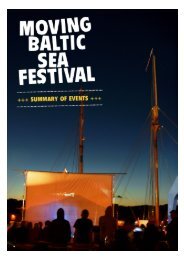the plotki magazine (pdf) - Moving Baltic Sea
the plotki magazine (pdf) - Moving Baltic Sea
the plotki magazine (pdf) - Moving Baltic Sea
Create successful ePaper yourself
Turn your PDF publications into a flip-book with our unique Google optimized e-Paper software.
← S T O R I E S F R O M T H E S E A S I D E 〈 〈 〈 〈 〈concrete block extending in one interminable stretchparallel to <strong>the</strong> coast, making us feel very small and soft.With <strong>the</strong> standard holiday lasting ten days, it was largeenough for two million vacationers to enjoy <strong>the</strong> <strong>Baltic</strong>seaside between spring and fall every year, for two millionpairs of eyes to look out of <strong>the</strong> windows every bedroomfaces <strong>the</strong> sea and take in <strong>the</strong> view, for two millionpairs of legs to cross <strong>the</strong> stretch of sand and plungeinto <strong>the</strong> blinking bracing water, for two million mouthsto open and close around forks in <strong>the</strong> vast dining hallsplaced at regular intervals between <strong>the</strong> dormitory wings.Everyone toge<strong>the</strong>r, everyone <strong>the</strong> same, everyone happyand strong and joyful, thanks to <strong>the</strong> <strong>Baltic</strong> <strong>Sea</strong>, thanksto <strong>the</strong> air and <strong>the</strong> sand and <strong>the</strong> seagulls, thanks to <strong>the</strong>robust Aryan blood in <strong>the</strong>ir veins, thanks to <strong>the</strong> buildersand <strong>the</strong> architects one of whom was appropriatelynamed Clemens Klotz (German for big heavy shapelessblock) , thanks to <strong>the</strong> party. Generous funding of KdFprojects meant that <strong>the</strong> workers would only be charged2 Reichsmark a day, covering everything from room andboard to bath towels.All of this was hard to imagine as we stood in front of<strong>the</strong> empty shell of a building that spring morning, <strong>the</strong>weeds all along it crunchy with broken glass, slim treesgrowing on <strong>the</strong> roof, <strong>the</strong> 150,000 cubic meters of woodthat were felled to make room for <strong>the</strong> building slowlywinning back territory. Signs were posted at regular intervalswarning of risk to life and limb, <strong>the</strong> doors boardedup, but we finally found an unsecured entrance andwandered around <strong>the</strong> decimated insides of <strong>the</strong> place,stripped of every removable object, except for someposter scraps on a wall here and <strong>the</strong>re (Tom Cruise andJohn Travolta who on earth hung those up?). On oneof <strong>the</strong> landings we found a neat pile of black fire stonesfrom <strong>the</strong> beach, each seemingly chosen with great careand left <strong>the</strong>re, full of some kind of meaning we couldnot decipher. O<strong>the</strong>rwise <strong>the</strong> endless hallways and nakedrooms contained nothing but shards of glass, bits oftrash, and <strong>the</strong> unreal, gorgeous view of <strong>the</strong> sea through<strong>the</strong> windows. A quote attributed to Gorbachev waspainted onto <strong>the</strong> pocked plaster of one of <strong>the</strong> walls (“In<strong>the</strong> nuclear age, saving <strong>the</strong> earth from nuclear destructionis <strong>the</strong> responsibility of all of humanity, <strong>the</strong> concernof all peoples”). We had to pick our way around puddlesof black water ominously standing in <strong>the</strong> hallways andwe were cold, <strong>the</strong> thick walls having a refrigerating effect,so we didn’t linger long and were glad to be outsideagain in <strong>the</strong> sunshine.But <strong>the</strong>n were drawn right back in, unable to resist <strong>the</strong>hysterically advertised private museum (“500 meters to<strong>the</strong> museum!” “400 meters to <strong>the</strong> museum!” “300 metersto <strong>the</strong> museum!”) in one of <strong>the</strong> wings, which, alongwith a floor devoted to motorcycles made in <strong>the</strong> GDR,includes an exhibition on <strong>the</strong> history of <strong>the</strong> matchlessKdF project. Building began in 1936, we learned, andcame to a halt in 1939 when Germany went to war andall resources and manpower were diverted to what hadbecome <strong>the</strong> nation’s only cause and purpose, leaving notime or money for working-class leisure. The half-finishedconstruction was used for military training until<strong>the</strong> Soviets came and dismantled parts of it for buildingmaterials. They also interned dispossessed propertyowners, whose seafront villas were “refunctioned,” andhoused refugees from <strong>the</strong> East in <strong>the</strong> wings that remainedintact. We wondered if any of <strong>the</strong>se involuntaryresidents knew or appreciated <strong>the</strong> fact <strong>the</strong>y were livingin a holiday resort.The exhibition also boasts a continuously loopingdocumentary film in which every contemporary witnesswaxes nostalgic about <strong>the</strong> war (“Those were goodtimes,” a radio operator instructor reminisces, and seeing<strong>the</strong> photo of him, one grinning young man and acheery gaggle of young women in a we’re-away-fromhomemood, we thought, “sure bet it was”), and a modelof what <strong>the</strong> finished 4.5 km-long structure was intendedto look like. Yes, that’s four point five kilometers. Even<strong>the</strong> model is overwhelming. The tiny trees and bushesneatly lining <strong>the</strong> cardboard paths are interspersed withlittle red and white flags, red with a blank white circle in<strong>the</strong> middle, scrubbed clean of those indecorous swastikas,giving <strong>the</strong> impression <strong>the</strong> KdF Seebad Prora was aJapanese development, only backwards. The museumis an information overload, screaming block letterseverywhere, pointing you this way and informing you ofthat, reams of photocopied texts and newspaper clippingson every square inch of wall. But it wasn’t until wedid some research back at home that we confirmed forcertain that <strong>the</strong> “Colossus of Rügen” had never actu-17



